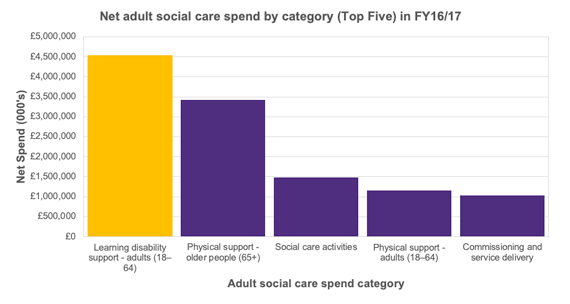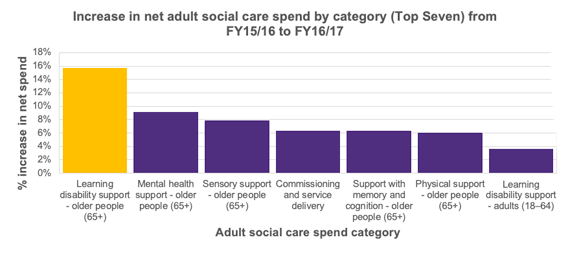
Better modelling of demand by local authorities can help reduce – if not eliminate – the projected rise in costs for learning disability services, says Nick Clarke.
While a lot of the recent media coverage around adult social care has focused on our ageing population, one particular area of care has often been overlooked – the provision of services to people with learning disabilities.
The overall cost of providing these services has, for many local authorities, overtaken the cost of providing services to older people.
In 2016/17 alone, total net spend on learning disability support for adults aged 18-64 increased by 3.6%, equating to nearly £160m of extra costs1.
First, the good news
There is a positive story behind this increase in spend, as it is being driven by three primary factors:
- More people with profound learning disabilities are surviving childhood compared to 20-30 years ago;
- They are living for longer but often with more complex social care and health conditions;
- More are now living in community settings (but we still have further to go).
This is a great testament to the NHS and advances in medical care; to local authorities and social workers; to care providers; and most importantly to the tens of thousands of carers – paid and unpaid – who support, care for, and love some of the most vulnerable people in our society every single day, largely without reward or recognition.
At a time when it seems our society is getting ever more polarized, this can only be a good thing.
The challenge ahead
These demand factors, however positive, are not going to slow down.
In fact, based on our recent modelling work for a number of local authorities, we forecast that both demand and costs in adult learning disability services will likely increase for many local authorities at a greater rate than previously (5% plus) over the next five years.
That would equate to an increased total net spend of £1.25bn by 2022/23.
And that’s just for learning disability support for adults aged 18-64.
For learning disability support for adults aged over 65, net spend by local authorities increased by nearly 16%2 over the period 2015/16 – 2016/17.
At a time when significant budget pressures on social care services are expected to continue, for local authorities to find another £1bn-plus a year for learning disability services within five years feels unachievable.
The cuts to other service areas that would need to be made to fund this gap would need to be even deeper than what is already happening across the country.
A Partial Way Forward
There is very little local authorities can do to slow the demand for learning disability services in the short to medium term.
However, demand and cost increases do not necessarily have to continue on the same trajectory.
It is our view that the forecast cost increase in learning disability services can be reduced, but not eliminated, over the next five years.
But how?
The starting point is a rigorous and robust model to understand your future demand – where is it coming from, what are the likely needs profile of individuals and thus what specific services and accommodation will be required to meet this future demand?
This can all be modelled with a significant degree of accuracy because the demand for, and duration of providing learning disability services is largely stable and well-known – in a way that is not the same for older people’s services.
Why is this important?
Because it can allow local authorities to produce more comprehensive strategic plans and commissioning for the future, based on real and accurate data insight.
Many local authorities are currently constrained by what they can and cannot do for people with learning disabilities because the market for some support services and/or accommodation either does not exist or has little to no capacity.
A classic example would be an individual, new to a local authority learning disability service, who would ideally be placed in a specific type of supported living scheme with “wraparound” services.
That scheme may not exist or there may be no capacity in borough.
So, the local authority is left in the unenviable position of either placing the individual in a different (but not ideal) supported living scheme in borough, or in an out-of-borough scheme many miles from the individual’s family and friends, or in residential care.
All of which are likely to cost the local authority more and does not provide the best support for the individual.
Is this forecasting currently happening?
Yes, in a minority of councils.
But forecasting, and the consequent development of the wider care market requires time, people and focus.
Our experience is that market development is a huge opportunity but councils risk misfiring without a rigorous grip on the data and a robust forecast.
1. Adult Social Care Activity and Finance: England 2016-17
2. Adult Social Care Activity and Finance: England 2015-16 and 2016-17
Nick Clarke is director of social care insights at Grant Thornton















